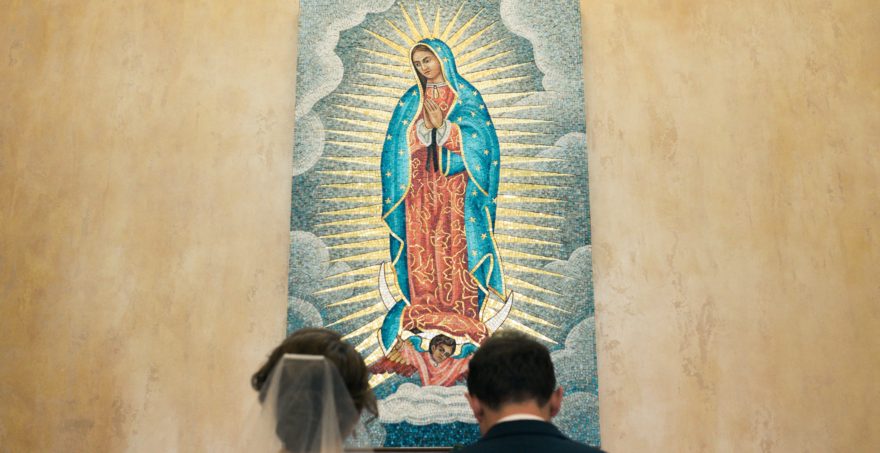Getting to Know Mother Mary

When you think about the Catholic Church in Latin America, one of the first things that probably first comes to mind is Mary, and for good reason. Mary seems to be everywhere down here. No church is without a statue in her honor, usually Our Lady of Mt. Carmel, who is Chile’s most popular Marian devotion, and Marian hymns are a common feature of Mass. On several occasions, I have been to churches who include her in the petition response, saying “con Maria rogamos” (with Mary we pray), and a popular way to end the Mass, just after the final blessing, is by “greeting” the Blessed Virgin with a Hail Mary or other Marian prayer.
Besides her very visible presence in the Church, she is often seen in secular society as well. In many of the small shops around Santiago, her image can be seen in the window or on the wall behind the counter. One of the most popular parks in Santiago, a large hill that rises above Santiago’s inner city area, features at its highest point a shrine to the Immaculate Conception and an enormous statue of Mary that can be seen for miles around. (Think a smaller, Marian version of Rio de Janeiro’s Jesus statue.) I can actually see it right now from my apartment as I write this post.
As though all of these things were not enough to show Mary’s tremendous religious and cultural influence here, there is also that fact that a very sizable portion of the female population is named Maria, and it is not uncommon for couples to name several or even all their daughters after the Blessed Virgin. No wonder so many women go by their middle names.
For me, an American, this was all a little strange. In United States Catholicism, Mary tends to take a more peripheral role in the Church and my own spirituality was Christocentric, almost to the exclusion of Mary. I studied theology in college, so I was very familiar with Church doctrine, but while I knew a lot about Mary, I didn’t really know Mary.
So when Juan and I began to search for a Catholic community with which to become more involved, I never thought we’d end up becoming part of a distinctly Marian movement like Schoenstatt. But, in what I believe was the answer to many prayers, that is exactly where we ended up. We began attending Mass at the Schoenstatt shrine about a year ago, and last month we had the opportunity to attend some introductory sessions to begin formation in the marriage branch of the movement, which consists of groups of married Catholic couples who share the movement’s Marian spirituality, and who seek to have holy and happy marriages and families.
For Juan, I think Marian spirituality came more naturally. He grew up in a Marian culture, and his grandfather had a very strong devotion to Our Lady of Mt. Carmel. I however, despite loving the formation we have received from the Schoenstatt movement, still felt a little awkward about the Marian aspect until the most recent session.
In that session, one of the sisters explained the Marian spirituality of Schoenstatt. Mary, she pointed out, is often highly idealized, which can make her seem distant, even in a culture where she is very visible. Yet when we speak of Mary, we are speaking about a real human woman who gave an incredible “yes” to God and became the Mother of the second Person of the Most Blessed Trinity, and by Jesus’ gift on the Cross, our mother as well. Mary is Mother.
As a mother, she did all the things that mothers do. She gave birth to her child, cared for Him, and loved Him. She ran a home at Nazareth and cooked and cleaned the home and cared for little Jesus when He was sick. Through all the little tasks of life, she served God in tangible ways. Her example shows us that every little action we do can, and should, be done in service to God. In other words, Mary is not a distant and inaccessible figure, but a model for our everyday life. She is our Mama.
One of the women in our group said that when life gets crazy or difficult, she says a little prayer to Mary, saying, “Virgencita, in your life you must have gone through something similar. Help me to serve God in this as well.”
While I knew intellectually that Mary is model of Christian discipleship, I didn’t start to really get it until last week.
Mary’s gaze is always toward her Son. We have nothing to fear about devotion to Mary, as she will only bring us closer to Jesus, and everything to gain by her maternal care and perfect example of discipleship. After all, where Jesus is, there too is Mary. As Pope Francis rather humorously put it in his address to members of Schoenstatt on their 100th year anniversary, you can either accept Mary as you mother, or she’ll be your mother-in-law. Either way, she’s there, and an authentic devotion to Christ is always enriched by a love for His mother.
Juan and I feel truly blessed to have begun our journey with Schoenstatt right from the beginning of our marriage preparation. We know that marriage will be difficult at times and that we are two very imperfect human beings, but we pray that Mary’s perfect example as wife, mother, and disciple will inspire us to be more selfless spouses, excellent parents, and faithful disciples of the Word.
Just five weeks until the big day! Mother Mary, pray for us!





